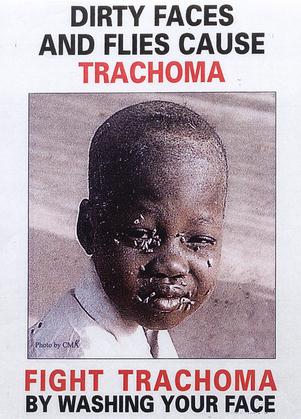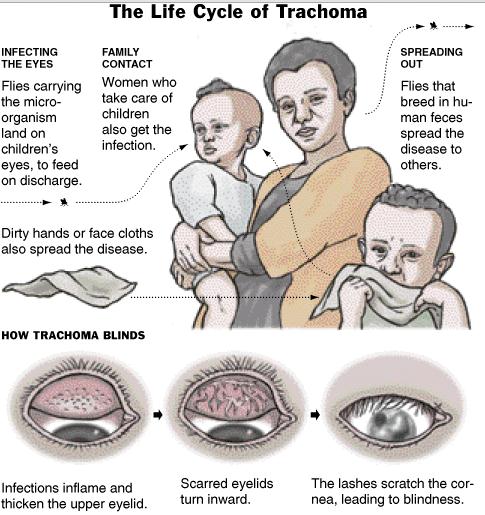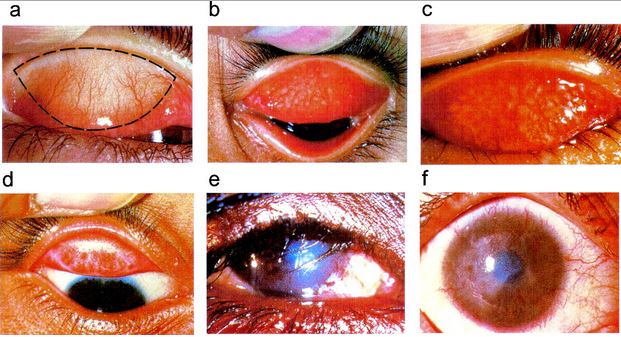Trachoma – Definition, Symptoms, Treatment, Pictures, Causes
What is Trachoma?
Trachoma comes from the ancient Greek, meaning rough eye. Trachoma is also known as sandy blight, granular conjunctivitis and Egyptian opthalmia. It is an infectious eye disease. If left untreated, it results in blindness. This type of eye disease spreads fast. It is a water-born kind of disease. It is a serious condition, which mostly occurs in the developing world, usually found in the Aboriginal communities or communities with poor health.

fig 1
Trachoma Symptoms
When one has this kind of eye disorder, he or she will manifest the following signs and symptoms:
- Mild itching
- Irritation of the eyelids and eyes
- Mucus or pus discharge
- Photophobia or sensitivity to light
- Eye pain
- Blurring of vision
- Abnormal growth of corneal blood vessels
- Opaque cornea
- Redness of the conjunctivitis
- Inflammation in the lymphoid follicles and inside the upper eyelid
- Trichiasis or turned-in eyelashes
- Throat and ear complication
Trachoma Causes
Trachoma exists because of the bacteria Chlamydia Trachomatis. It is a bacterium related to Chlamydia, a sexually transmitted disease condition. It is transmitted from one person to another by means of:
- Direct contact, like touching the secretions of the infected eyes, nose or throat.
- Indirect contact, such as touching items that are contaminated like towels, blankets, clothing, sheets, handkerchiefs and the like.
- Flies that seeks the eyes are considered to be a major transmission.

Fig 2

Image 3
Trachoma Grading
There are actually two grading systems when trachoma is diagnosed. One is called the McCallan’s classification and the other is the WHO classification.
The McCallan’s classification categorizes the trachoma in four stages:
Stage 1
Known as Incipient Trachoma. It is described as the hyperemia of the palpebral conjunctiva that has an immature follicle.
Stage 2
Establish trachoma, which has a characteristic of having a mature follicle and papillae. It is considered as a progressive corneal pannus.
Stage 3
Cicatrising trachoma is another term for this stage. It deals with the scarring of the palpebral conjunctiva and its scars are visible as white bands.
Stage 4
It is the last and final stage, which is healed trachoma. It is when the disease is cured or is not markable. It is sequelae to cicatrisation that causes the symptoms.
Meanwhile the WHO or the World Health Organization recommends a much simpler grading system for persons with trachoma. The grading system is summarized below:
(TF) Trachomatous inflammation, follicular
The person is first infected with the causative agent named Chlamydia bacteria; the upper eyelid of the person will manifest inflammation and have a presence of white follicles. Most often the cases that develop in this stage are of mild form and will develop over a few weeks or months.
(TI) Trachomatous inflammation, intense
Here the infected person will experience a severe inflammatory response and their eyes have water or white discharge. They will find sunlight unbearable or have Photophobia symptoms. They will also experience eye pain.
(TS) Trachomatous scarring
Here there is a repeated resolution and active inflammation cycle that leads to the scarring of the lining of the lid of the infected persons. More infection that occurs will lead to more scarring and then the scar will lead to a network of scars.
(TT) Trachomatous trichiasis
As time passes, the scars contracts and will shorten the innermost lining of the person’s eye. TT will pull the lash nearer to the eyes as it will shorten the patient’s lid margin. As it progresses, the eyelashes will be pulled around until they touch the eye’s cornea, which will lead to the damage called trichiasis.
(CO) Corneal opacity
The trichiasis will become painful and more lashes will rub against the patient’s eyes. Patients will report that they tend to stay indoors than outdoors because they find it uncomfortable and unbearable to go out because of the presence of sunlight, smoke and dust. In addition to that, other infections will develop. When scratching and infection combine, it will lead to opacity of the cornea, which will then lead to vision loss. Patients in this stage will report being blind or having near blindness.
Trachoma Diagnosis
In confirming the trachoma diagnosis, the physician will do the following necessary actions:
- Physical Examination, including eye examination
- Medical History
- Eye swab or culture for laboratory testing and to verify if Chlamydia is really present
Trachoma Treatment
With regards to the treatment of persons diagnosed with trachoma, the WHO or the World Health Organization recommends the acronym SAFE which means:
- Surgery that will repair the damage and infected eye
- Antibiotics for the infection treatment
- Face washing to reduce spreading the infection to other areas
- Environmental changes, such as clean water and healthy sanitation
Surgery
The surgery is intended as the last step. That is if antibiotics and all other treatment fail. Eyelid rotation surgery can be done when the person’s scarring eyelids lead the eyelashes to turn inwardly. Upon the surgical operation, there will be an incision made in the person’s upper eyelid and the lashes will be rotated away from the person’s cornea. It is usually done under local anesthesia. It takes about 15 minutes for the surgery to be complete. In case there is visual impairment, transplanted corneas is the best option.
Medications
As mentioned earlier, the first treatment method in treating persons diagnosed with trachoma is through antibiotic medication. Antibiotics are needed, especially during the earliest stages of the eye disorder. The two drugs that are mostly prescribed for this kind of eye disease are oral azithromycin and Tetracycline eye ointment. It works as a bacteria killer so as that the body’s natural process of healing can repair the damage eyes.